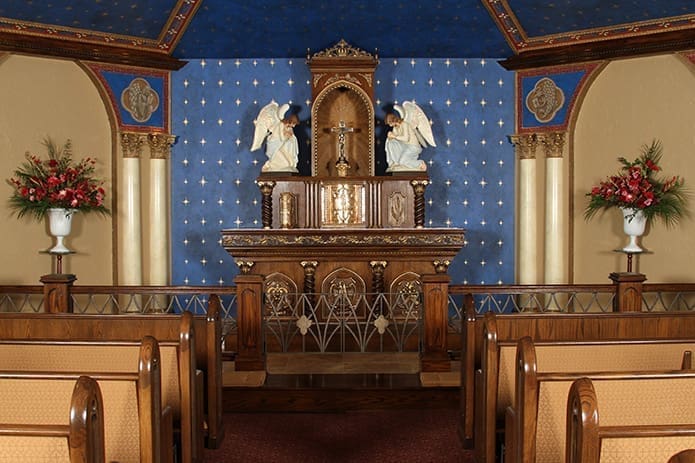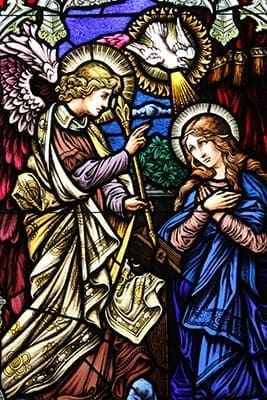 Photo By Michael Alexander
Photo By Michael AlexanderDuluth
Many volunteers build love into adoration chapel, new hall at St. Monica’s
By NICHOLE GOLDEN, Staff Writer | Published August 7, 2014
DULUTH—The new “Mary, Mother of the Eucharist Chapel” at St. Monica Church is an awe-inspiring space where parishioners and visitors can pray without distraction before the Blessed Sacrament.
The adoration chapel, blessed by Bishop Luis R. Zarama on Sunday, June 1, includes a monstrance from France, hand-carved altar panels, stenciled ceiling patterns and stained glass windows modeled on designs from 18th-century Germany.
Cyndy Furgiuele, the parish coordinator of first Communion, had dreamed of such a space but said that it’s beyond her imagination.
“It’s so beautiful and detailed. It’s unbelievable,” said Furgiuele. “Everything in that chapel raises your mind to God.”

The new 13,000-square-foot parish center at St. Monica Church in Duluth includes St. Augustine Hall, right, and the Mary, Mother of the Eucharist Chapel, left. The parish hall can seat 400 people for events and 250 for banquets. It also has a stage and a built-in dance floor, along with an extremely high tech audio/video/lighting system. The new hall’s kitchen comes equipped with 24 feet of cooking hood space and a very large pantry. Photo By Michael Alexander
The adoration chapel is part of a larger building project. The parish community is also celebrating completion of St. Augustine Hall, a 13,000-square-foot extension that will help the growing parish host gatherings, provide overflow seating for Masses, and offer adult education with audiovisual technology.
St. Monica in Duluth was first established in 1994 as a mission of St. Benedict Church, which is now considered to be in Johns Creek. Church construction began in 1999 and was completed the following year. By 2002, St. Monica’s membership had grown from 1,000 to 2,400 families.
In 2007, the church was busting at the seams, said Joe Lenzi, a parishioner for 12 years.
Lenzi said a few people were chatting one day about the growth and possible expansion with Father Jack Durkin, the pastor.
There were no funds available for expansion, but Father Durkin suggested that everyone set phone alarms for noon to pray the Angelus daily seeking the graces needed for a building campaign.
“That whole project was built in prayer,” said Lenzi.
‘You will feel the love’
Construction started in May 2013 and ended in January 2014, but parish volunteers continued on after that.
When a capital campaign fell short, volunteers gave their time to finish the interiors of the hall and the chapel, helping to meet the budget.
“Many of our parishioners stepped up and offered their talents and skills. It was a wonderful collaborative effort,” said Father Durkin.
“You will feel the love,” said Lenzi about a first-time visit to the chapel. “Everybody feels a part of it.”
Lenzi spends an hour in prayer at the chapel each Thursday and is noticing other members of the parish Men’s Club doing the same more frequently. “I can see the enthusiasm building,” he said.
A chapel committee planned the overall design and symbols to be used in the chapel with most of the labor and materials donated and a mostly volunteer crew assisting. A non-Catholic gentleman also joined in the work, wanting to glorify God through the endeavor.

The image of the Annunciation is one of five stained glass windows in the Mary, Mother of the Eucharist Chapel at St. Monica Church in Duluth. The other windows depict the Holy Family, the flight into Egypt, the Presentation of Mary, and the Assumption. Photo By Michael Alexander
“It’s almost like entering into the heart of Our Lady,” said Father Durkin about the chapel’s design.
The crew of artisans and laborers handled every detail from the painting of ceilings, construction of the altar, and trim work.
“They came out of the woodwork,” said Holly Meyer, chapel committee member. “Who knew we had such talent?”
Furgiuele, who also served on the committee, said the collaborative effort reminded her of the old days of the church when craftsmen worked collectively to create the breathtaking chapels and cathedrals of the world.
When additional funds were needed for the stained glass windows, people just started giving.
“It is such a grassroots’ effort,” she said.
“Every element of the design was purposeful,” noted Meyer. “We looked for quality liturgical items from churches that had closed. We found the monstrance in France, the tabernacle and angels in Cleveland, Ohio.”
The stained glass windows were modified from a German design and replicated by a company in Virginia. The windows depict the Holy Family, the flight into Egypt, the Presentation of Mary, the Annunciation and the Assumption.
A parishioner built the altar with assistance from others and included a starburst veneer pattern behind the monstrance. Lighting overhead brings further attention to the monstrance.
A Marietta artist carved the panels for the altar’s front. Other embellishments include wheat carvings on either side of the tabernacle and turned columns with hand-carved capitals. The altar is adorned with a gold leaf crown. Jewels donated in the offertory basket were placed into the crown by a local jeweler free of charge. Rubies will be used as the blood drops from the heart of the pelican on the center altar panel. A pelican symbolizes Jesus and sacrificial love.
‘Under Mary’s mantle’
The chapel’s ceiling design was inspired by the Basilica di Santa Maria Sopra Minerva Church in Rome, Italy, and Sainte-Chapelle, the Gothic chapel in the heart of Paris. The color is a deep blue.
The crew spent months of painstaking effort creating and applying ceiling details for the chapel. Hand-cut stencil designs, painted within the arched bands of molding on the main ceiling, represent the rosary. Ten dogwood flowers signify the Hail Mary prayers and a Sacred Heart symbol represents the Our Father. A center medallion flower also represents Mary and the 12 stars surrounding the flower, her crown.
Patterns of grapes and wheat are representative of the body and blood of Christ. Other symbols incorporated were those of the Trinity, the fleur-de-lis for Mary, the Chi-Rho symbol of Christ, and the inscription above the crucifix at Calvary. Paintings of the Gospel evangelists are situated above columns.
Pam Colker, a mother of 10 and parishioner for four years, said she would peek in and monitor the progress of the chapel every now and then, but that the overall beauty of the space was ultimately so surprising.
“It’s as if you are under Mary’s mantle,” said Colker. “All of it is designed to help you become more prayerful … more interiorly silent.”
The family has participated in adoration in the main church, but will likely spend more time in the quiet adoration chapel, she said.
“This space just makes it possible to go in there any time,” she said.
Colker’s 20-year-old daughter has been visiting the chapel daily, and her 18-year-old visits once or twice a week.
Father Durkin said that while the chapel is now open only during church hours, the plan is to generate enough commitment to keep it open 24 hours a day.
The pastor explained that the chapel has been the “fruit of a good desire.”
Father Durkin said that the religious education program at St. Monica includes much time introducing children to the devotion of silent prayer, as well as reacquainting older parishioners with adoration.
The beauty of art has played a role in the life of St. Monica Church since its beginnings.
Atlanta artist Jim Bell produced the crucifix and the near life-sized ceramic statues of the Holy Family, St. Augustine and his mother, St. Monica, St. Peter, St. Paul, as well as the church’s baptismal font. There is also a pastel portrait of St. Monica, by artist Kathryn Gentile, a founding member, in the narthex.
The symbols of the chapel can also offer parents teaching moments. Colker pointed out that the arms of the angels beside the tabernacle have a meaning. The angel with arms crossed over the chest symbolizes love, and the angel holding hands clasped in prayer means faith.
“The good thing to see is families,” said Father Durkin, of the chapel’s visitors.
Furgiuele says she knows of a mother whose toddler struggles to be quiet in Mass, but when they visit the chapel, the child is perfectly still.
Father Durkin believes that the chapel will be an important place for people who may not otherwise have access to beautiful spaces or are coming from broken or loud situations. At the chapel, visitors can work on cultivating the interior life.
“They can go to a place that’s orderly, beautiful and quiet,” said Father Durkin. “Come out and pray. Join us.”